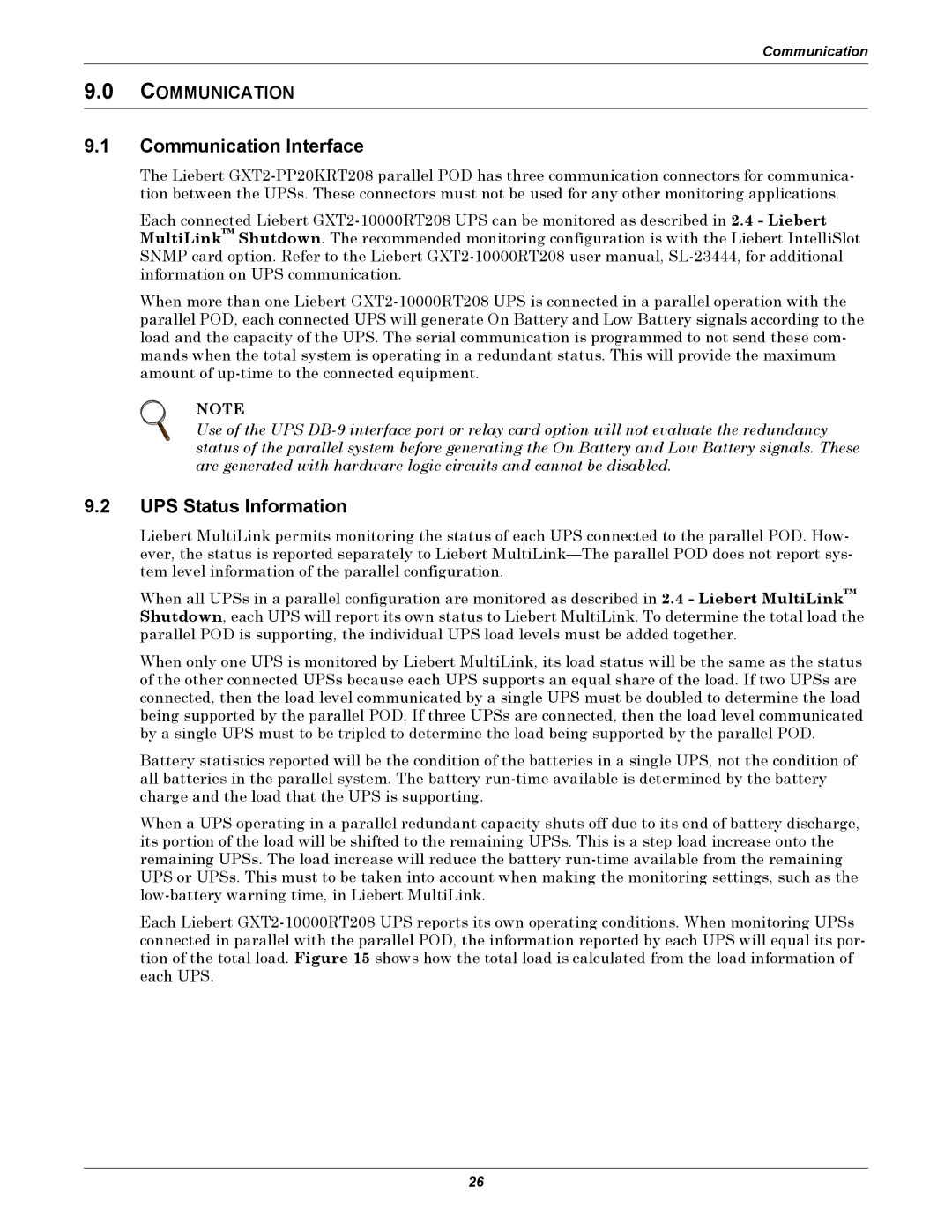Communication
9.0COMMUNICATION
9.1Communication Interface
The Liebert GXT2-PP20KRT208 parallel POD has three communication connectors for communica- tion between the UPSs. These connectors must not be used for any other monitoring applications.
Each connected Liebert GXT2-10000RT208 UPS can be monitored as described in 2.4 - Liebert MultiLink™ Shutdown. The recommended monitoring configuration is with the Liebert IntelliSlot SNMP card option. Refer to the Liebert GXT2-10000RT208 user manual, SL-23444, for additional information on UPS communication.
When more than one Liebert GXT2-10000RT208 UPS is connected in a parallel operation with the parallel POD, each connected UPS will generate On Battery and Low Battery signals according to the load and the capacity of the UPS. The serial communication is programmed to not send these com- mands when the total system is operating in a redundant status. This will provide the maximum amount of up-time to the connected equipment.
NOTE
Use of the UPS DB-9 interface port or relay card option will not evaluate the redundancy status of the parallel system before generating the On Battery and Low Battery signals. These are generated with hardware logic circuits and cannot be disabled.
9.2UPS Status Information
Liebert MultiLink permits monitoring the status of each UPS connected to the parallel POD. How- ever, the status is reported separately to Liebert MultiLink—The parallel POD does not report sys- tem level information of the parallel configuration.
When all UPSs in a parallel configuration are monitored as described in 2.4 - Liebert MultiLink™ Shutdown, each UPS will report its own status to Liebert MultiLink. To determine the total load the parallel POD is supporting, the individual UPS load levels must be added together.
When only one UPS is monitored by Liebert MultiLink, its load status will be the same as the status of the other connected UPSs because each UPS supports an equal share of the load. If two UPSs are connected, then the load level communicated by a single UPS must be doubled to determine the load being supported by the parallel POD. If three UPSs are connected, then the load level communicated by a single UPS must to be tripled to determine the load being supported by the parallel POD.
Battery statistics reported will be the condition of the batteries in a single UPS, not the condition of all batteries in the parallel system. The battery run-time available is determined by the battery charge and the load that the UPS is supporting.
When a UPS operating in a parallel redundant capacity shuts off due to its end of battery discharge, its portion of the load will be shifted to the remaining UPSs. This is a step load increase onto the remaining UPSs. The load increase will reduce the battery run-time available from the remaining UPS or UPSs. This must to be taken into account when making the monitoring settings, such as the low-battery warning time, in Liebert MultiLink.
Each Liebert GXT2-10000RT208 UPS reports its own operating conditions. When monitoring UPSs connected in parallel with the parallel POD, the information reported by each UPS will equal its por- tion of the total load. Figure 15 shows how the total load is calculated from the load information of each UPS.

